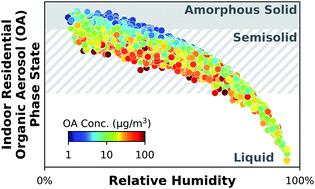当前位置:
X-MOL 学术
›
Environ. Sci.: Processes Impacts
›
论文详情
Our official English website, www.x-mol.net, welcomes your
feedback! (Note: you will need to create a separate account there.)
Indoor aerosol water content and phase state in U.S. residences: impacts of relative humidity, aerosol mass and composition, and mechanical system operation
Environmental Science: Processes & Impacts ( IF 4.3 ) Pub Date : 2020-08-14 , DOI: 10.1039/d0em00122h Bryan E. Cummings 1, 2, 3 , Ying Li 3, 4, 5 , Peter F. DeCarlo 3, 6, 7 , Manabu Shiraiwa 3, 4, 5 , Michael S. Waring 1, 2, 3
Environmental Science: Processes & Impacts ( IF 4.3 ) Pub Date : 2020-08-14 , DOI: 10.1039/d0em00122h Bryan E. Cummings 1, 2, 3 , Ying Li 3, 4, 5 , Peter F. DeCarlo 3, 6, 7 , Manabu Shiraiwa 3, 4, 5 , Michael S. Waring 1, 2, 3
Affiliation

|
Hygroscopic particulate matter (PM) constituents promote uptake of aerosol water (AW), depending on relative humidity (RH), which can constrain qualities such as organic aerosol (OA) phase state and inorganic aerosol (IA) deliquescence and efflorescence. This work provides a first incorporation of AW predictions into residential indoor PM simulations. The indoor model, IMAGES, which simulates factored OA concentrations and thermodynamics using the 2D-volatility basis set, was expanded to predict speciated IA concentrations, AW with κ-Köhler theory of hygroscopic growth, and OA phase state with glass transition temperatures. Since RH is the largest driver of AW and varies with meteorology, simulations were conducted using a database of historical ambient weather and pollution records spanning the sixteen U.S. climate zones, facilitating assessment of seasonal and regional trends. Over this diverse simulation set, the residential indoor AW mass was ∼10 to 100 times smaller than dry PM mass. This relative AW amount indoors was about ∼10 times smaller than outdoors, since indoor-emitted aerosol is likely less hygroscopic. The indoor OA phase state was typically semisolid, suggesting kinetic limitations might inhibit thermodynamic OA partitioning equilibrium from being established indoors. Residences in hot and humid climates during the summertime may have liquid indoor OA, while amorphous solid indoor OA can exist in cold climates. Deliquescence and efflorescence of recirculated IA within HVAC systems during cooling or heating, respectively, was also modeled. Oftentimes, two IA populations with different histories existing as wet or dry aerosol were generated by HVAC operation depending on indoor and outdoor environmental conditions and the HVAC operating mode.
中文翻译:

美国住宅中的室内气溶胶水含量和相态:相对湿度,气溶胶质量和组成以及机械系统运行的影响
吸湿性颗粒物(PM)成分根据相对湿度(RH)促进气溶胶水(AW)的吸收,这会限制诸如有机气溶胶(OA)相态和无机气溶胶(IA)潮解和风化的质量。这项工作首次将AW预测合并到住宅室内PM模拟中。使用2D波动率基础集模拟室内OA浓度和热力学的室内模型IMAGES进行了扩展,以预测特定的IA浓度,AW为κ-Köhler的吸湿性增长理论以及玻璃化转变温度下的OA相态。由于RH是AW的最大驱动因素,并且随气象而变化,因此使用跨16个美国气候区的历史环境天气和污染记录数据库进行了模拟,从而有助于评估季节性和区域趋势。在这个多样化的模拟组中,住宅室内AW质量比干燥PM质量小10至100倍。由于室内散发的气溶胶吸湿性较差,因此室内的相对AW量比室外小约10倍。室内OA相态通常为半固态,这表明动力学限制可能会抑制在室内建立热力学OA分配平衡。夏季炎热潮湿的住宅中可能会有液态室内OA,室内无定形固体OA可以在寒冷的气候中存在。还分别模拟了冷却或加热期间HVAC系统中再循环IA的潮解和风化。通常,根据室内和室外环境条件以及HVAC运行模式,通过HVAC运行会生成两个历史不同的IA种群,它们分别是湿气还是干气溶胶。
更新日期:2020-09-03
中文翻译:

美国住宅中的室内气溶胶水含量和相态:相对湿度,气溶胶质量和组成以及机械系统运行的影响
吸湿性颗粒物(PM)成分根据相对湿度(RH)促进气溶胶水(AW)的吸收,这会限制诸如有机气溶胶(OA)相态和无机气溶胶(IA)潮解和风化的质量。这项工作首次将AW预测合并到住宅室内PM模拟中。使用2D波动率基础集模拟室内OA浓度和热力学的室内模型IMAGES进行了扩展,以预测特定的IA浓度,AW为κ-Köhler的吸湿性增长理论以及玻璃化转变温度下的OA相态。由于RH是AW的最大驱动因素,并且随气象而变化,因此使用跨16个美国气候区的历史环境天气和污染记录数据库进行了模拟,从而有助于评估季节性和区域趋势。在这个多样化的模拟组中,住宅室内AW质量比干燥PM质量小10至100倍。由于室内散发的气溶胶吸湿性较差,因此室内的相对AW量比室外小约10倍。室内OA相态通常为半固态,这表明动力学限制可能会抑制在室内建立热力学OA分配平衡。夏季炎热潮湿的住宅中可能会有液态室内OA,室内无定形固体OA可以在寒冷的气候中存在。还分别模拟了冷却或加热期间HVAC系统中再循环IA的潮解和风化。通常,根据室内和室外环境条件以及HVAC运行模式,通过HVAC运行会生成两个历史不同的IA种群,它们分别是湿气还是干气溶胶。











































 京公网安备 11010802027423号
京公网安备 11010802027423号